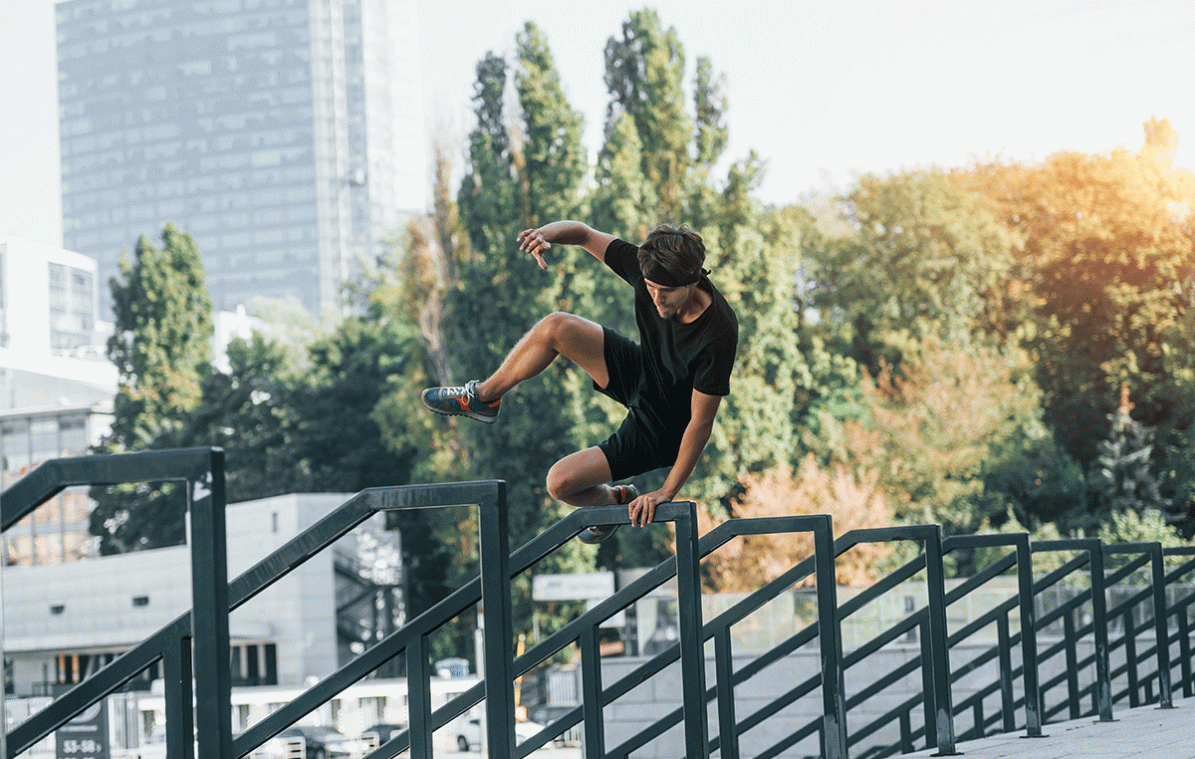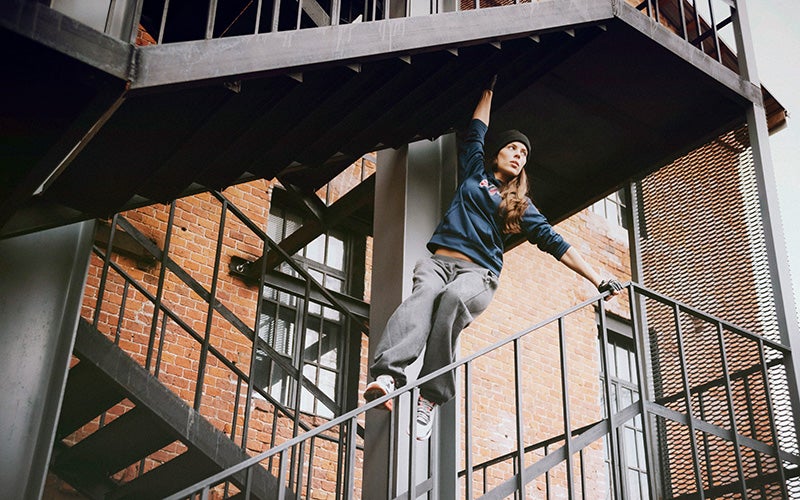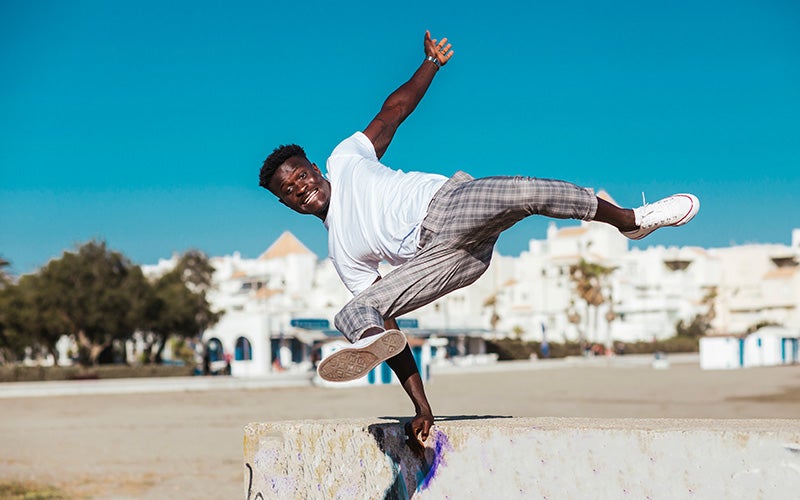Parkour: More Than Just Stunts
 © mstandret
© mstandret
Jumping over barriers, balancing on narrow ledges, and climbing up walls: Parkour runners overcome every obstacle with ease and grace. As a sport, parkour is challenging and exciting, and it strengthens your connection to your environment. Ready to try it out? This article will help you prepare with the history behind the sport, potential dangers, and how you can get started without any previous experience.
What is Parkour?
Parkour, abbreviated PK, is a sport in which you move from point A to B over obstacles such as railings, stairs, walls, and houses without any extra help. The goal is to reach your destination as efficiently and effortlessly as possible. That’s why the sport is also called the “art of efficient locomotion.”
Parkour runners, also called traceurs, combine different forms of movement like climbing, jumping, and running. Everything is allowed, as long as the only thing you use is your own strength. The focus is on flow and movement control along the path.
In its original form, parkour is practiced in urban public spaces, but special parkour centers for working on parkour, freerunning, and related skills have also sprung up around the world. The sport is very demanding because it requires strength as well as stamina, balance, and coordination.
But parkour is much more than a sport; pro traceurs see it as an art form. It’s also a way to connect with other people and overcome challenges together, without necessarily competing. The sense of community is very important in parkour.
Where does the word parkour come from?
This particular form of movement was developed from the military obstacle courses or parcours du combattant by French soldier Raymond Belle and his son David Belle in the 1980s. In the 1990s and 2000s a variety of movies, documentaries, and commercials spread parkour around the world.
What Muscles Do You Train With Parkour?
Parkour is a challenging full-body workout, combining elements from many different sports like running, calisthenics, and climbing. There’s hardly any muscle you don’t use when you jump over barriers, climb up buildings, and balance over railings.
Since you’re constantly moving, you have to summon up strength as well as endurance and agility to get from A to B. Parkour also improves your coordination, sense of direction, strategic thinking, and concentration. You learn to focus and get a good sense for heights and distances.
Your self-discipline and self-assessment also improve. Everyone’s movements are determined by their own abilities and at their own pace. There is no right or wrong. The most important thing is to know your physical limits!
Don’t underestimate the social component: in its original form, parkour is not a competitive sport. Everyone masters the routes on their own, but when you’re out training, you’ll meet other athletes working on a run, and together you can work out the most efficient routes.

How Dangerous is Parkour?
Pro-level traceurs scale walls and jump across rooftops at dizzying heights: parkour runners in movies perform death-defying acts. Obstacle courses in an urban environment, where there are no safeguards, definitely come with a lot of risk. After all, any misstep can result in injury. Basically, every runner controls their own degree of difficulty and pace. Make sure you’re able to estimate both your abilities as well as heights and distances.
It’s also important to remember that parkour is not a competition. You’re not fighting the clock or an opponent, so you can take your time and approach obstacles with care to minimize your risk of injury.
Also you’re rarely alone when doing parkour. Your friends are there to watch out for you and intervene if someone ever starts to overestimate themselves.
Not quite ready for the streets? Parkour centers give you the structures you need to play, work on style, and train all the movement sequences from the ground up. They also have protective equipment like mats to make sure your risk of injury when you practice is extremely low. The better you get in the center, the safer you will feel later in the urban environment.
Who Should Do Parkour?
Parkour is for anyone looking for a challenging sport where you can test your limits. You should have a good basic fitness level and be interested in becoming part of a community.
If you’ve already tried bodyweight training, calisthenics, weightlifting, and rock climbing and are looking for new challenges, parkour might be just the thing for you.

Learn to Do Parkour: Tips for Beginners
Ready to explore freerunning or master parkour like the pros? Stop waiting and get ready to expand your comfort zone! The sport can be intimidating for newbies, so we’ve got a few tips to help you get started:
- Find a parkour group: If there’s no parkour centre near you, check out social media for experienced athletes first. They can show you the best routes in your area.
- Work on your strength, endurance, and agility: It pays to have some basics down before you tackle your first parkour leap. Regularly train your strength and endurance, as well as your agility, with jogging, weight training, calisthenics, and flexibility exercises. Balance exercises are also a good idea.
- Start slowly and know your limits: Even though parkour on courses with protective equipment is safer, don’t underestimate the risk of injury. Take your time to get a good sense for heights, distances, and hazards, as well as your own abilities, as you practice.
- Warm up: Make sure your tendons, ligaments, joints, and muscles aren’t unnecessarily overloaded during your parkour training by starting with a good warm-up. Need a refresher on why they’re so important? Check out our article on warm-ups!
- Recovery: Parkour is demanding and requires your entire body, so you need to give your muscles enough time to regenerate through sleep, active recovery, and the right nutrients, for example, with our Recovery Aminos.
- Eat a balanced diet: A diet with plenty of protein and carbs is the foundation for your practice. Don’t always have the time for a balanced, healthy diet? Our Whey Protein Shake is the ideal support for you and your muscle cells.
Similar Types of Sports
Looking for an alternative to parkour? Then you might like one of these similar sports:
Freerunning
Freerunning is often confused with parkour because the basic movements are the same and the acrobatics are still part of getting somewhere. But instead of emphasizing efficiency and the flow of movement, tricks like somersaults, handstands, and other complicated moves are in the spotlight.
Tricking
Tricking is a variation on freerunning that doesn’t incorporate any external structures to assist your movement, so you only rely on your own physical ability. The focus is on tricks like somersaults, twists, jumps, and spins in combination with martial arts elements.
Obstacle Courses
A classic obstacle course is a way of testing fitness in which athletes must overcome a set of obstacles in order to reach the finish line. Extreme obstacle courses with climbing, crawling, diving courses, or tire courses have also come up over the past decades due to the popularity of TV shows like Ninja Warrior. These kinds of competitions are sometimes known as “mud runs” – competitions in which participants conquer various obstacles and, as the name suggests, wade through mud.
Conclusion
- Originally developed by a French father-son duo, parkour is a sport in which you jump or climb over obstacles in public spaces, using only your own physical strength to get from point A to B as efficiently as possible.
- Parkour runners or traceurs move around the city, or in a special parkour center, by climbing, running, and jumping.
- The sport is a full-body workout that builds strength, endurance, agility, coordination, and concentration.
- The risk of injury is comparatively high in parkour, but you can reduce it by assessing your abilities correctly and training in a group. In parkour centers, safety measures help reduce the risk.
- Parkour, freerunning, and tricking are demanding sports, so a good level of basic fitness definitely gives you an advantage when you get started. Look for a group to join in your area!
Sources for this article
We at foodspring use only high-quality sources, including peer-reviewed studies, to support the facts within our articles. Read our editorial policy to learn more about how we fact-check and keep our content accurate, reliable, and trustworthy.





























